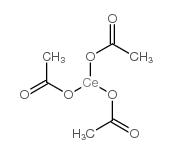Acetic acid, cerium(3+)salt, hydrate (2:3) (9CI)
Modify Date: 2025-08-25 17:16:09

Acetic acid, cerium(3+)salt, hydrate (2:3) (9CI) structure
|
Common Name | Acetic acid, cerium(3+)salt, hydrate (2:3) (9CI) | ||
|---|---|---|---|---|
| CAS Number | 17829-82-2 | Molecular Weight | 317.24800 | |
| Density | 10.94(Vapor Density) | Boiling Point | 117.1ºC at 760 mmHg | |
| Molecular Formula | C6H9CeO6 | Melting Point | 798ºC | |
| MSDS | N/A | Flash Point | 40ºC | |
| Name | cerium(iii) acetate hydrate |
|---|---|
| Synonym | More Synonyms |
| Density | 10.94(Vapor Density) |
|---|---|
| Boiling Point | 117.1ºC at 760 mmHg |
| Melting Point | 798ºC |
| Molecular Formula | C6H9CeO6 |
| Molecular Weight | 317.24800 |
| Flash Point | 40ºC |
| Exact Mass | 316.94500 |
| PSA | 78.90000 |
| LogP | 0.04140 |
| Vapour Pressure | 13.9mmHg at 25°C |
Synonym:Acetic Acid, Cerium(3+) Salt, Sesquihydrat Section 2 - COMPOSITION, INFORMATION ON INGREDIENTS
Risk Phrases: None Listed. Section 3 - HAZARDS IDENTIFICATION EMERGENCY OVERVIEW
Not available. Potential Health Effects Eye: May cause mild eye irritation. Skin: Low hazard for usual industrial handling. Ingestion: May cause irritation of the digestive tract. Inhalation: May cause respiratory tract irritation. Chronic: No information found. Section 4 - FIRST AID MEASURES Eyes: Flush eyes with plenty of water for at least 15 minutes, occasionally lifting the upper and lower eyelids. Get medical aid immediately. Skin: Get medical aid. Flush skin with plenty of water for at least 15 minutes while removing contaminated clothing and shoes. Wash clothing before reuse. Ingestion: If victim is conscious and alert, give 2-4 cupfuls of milk or water. Never give anything by mouth to an unconscious person. Get medical aid immediately. Inhalation: Remove from exposure and move to fresh air immediately. If not breathing, give artificial respiration. If breathing is difficult, give oxygen. Get medical aid. Notes to Physician: Treat symptomatically and supportively. Section 5 - FIRE FIGHTING MEASURES General Information: As in any fire, wear a self-contained breathing apparatus in pressure-demand, MSHA/NIOSH (approved or equivalent), and full protective gear. During a fire, irritating and highly toxic gases may be generated by thermal decomposition or combustion. Substance is noncombustible. Extinguishing Media: Use water spray, dry chemical, carbon dioxide, or appropriate foam. Section 6 - ACCIDENTAL RELEASE MEASURES General Information: Use proper personal protective equipment as indicated in Section 8. Spills/Leaks: Clean up spills immediately, observing precautions in the Protective Equipment section. Sweep up or absorb material, then place into a suitable clean, dry, closed container for disposal. Avoid generating dusty conditions. Provide ventilation. Section 7 - HANDLING and STORAGE Handling: Wash thoroughly after handling. Minimize dust generation and accumulation. Avoid contact with eyes, skin, and clothing. Avoid ingestion and inhalation. Use with adequate ventilation. Storage: Store in a cool, dry, well-ventilated area away from incompatible substances. Keep containers tightly closed. Section 8 - EXPOSURE CONTROLS, PERSONAL PROTECTION Engineering Controls: Use adequate ventilation to keep airborne concentrations low. Exposure Limits CAS# 17829-82-2: Personal Protective Equipment Eyes: Wear appropriate protective eyeglasses or chemical safety goggles as described by OSHA's eye and face protection regulations in 29 CFR 1910.133 or European Standard EN166. Skin: Wear appropriate protective gloves to prevent skin exposure. Clothing: Wear appropriate protective clothing to prevent skin exposure. Respirators: Follow the OSHA respirator regulations found in 29 CFR 1910.134 or European Standard EN 149. Use a NIOSH/MSHA or European Standard EN 149 approved respirator if exposure limits are exceeded or if irritation or other symptoms are experienced. Section 9 - PHYSICAL AND CHEMICAL PROPERTIES Physical State: Solid Color: white Odor: odorless pH: Not available. Vapor Pressure: Not available. Viscosity: Not available. Boiling Point: 3443 deg C Freezing/Melting Point: 798 deg C Autoignition Temperature: Not available. Flash Point: Not available. Explosion Limits, lower: Not available. Explosion Limits, upper: Not available. Decomposition Temperature: Solubility in water: Soluble. Specific Gravity/Density: Molecular Formula: Ce(C2H3O2)3 Molecular Weight: 317.1794 Section 10 - STABILITY AND REACTIVITY Chemical Stability: Stable under normal temperatures and pressures. Conditions to Avoid: Incompatible materials, dust generation, excess heat. Incompatibilities with Other Materials: Strong bases, strong acids, strong oxidizing agents. Hazardous Decomposition Products: Irritating and toxic fumes and gases, oxides of carbon. Hazardous Polymerization: Will not occur. Section 11 - TOXICOLOGICAL INFORMATION RTECS#: CAS# 17829-82-2: AF8490000 LD50/LC50: CAS# 17829-82-2: Draize test, rabbit, eye: 100 mg Severe; Oral, rat: LD50 = >5 gm/kg. Carcinogenicity: Cerium (III) Acetate, Hydrate - Not listed by ACGIH, IARC, or NTP. Other: See actual entry in RTECS for complete information. Section 12 - ECOLOGICAL INFORMATION Section 13 - DISPOSAL CONSIDERATIONS Dispose of in a manner consistent with federal, state, and local regulations. Section 14 - TRANSPORT INFORMATION IATA No information available. IMO No information available. RID/ADR No information available. Section 15 - REGULATORY INFORMATION European/International Regulations European Labeling in Accordance with EC Directives Hazard Symbols: Not available. Risk Phrases: Safety Phrases: WGK (Water Danger/Protection) CAS# 17829-82-2: No information available. Canada None of the chemicals in this product are listed on the DSL/NDSL list. CAS# 17829-82-2 is not listed on Canada's Ingredient Disclosure List. US FEDERAL TSCA CAS# 17829-82-2 is not listed on the TSCA inventory. It is for research and development use only. SECTION 16 - ADDITIONAL INFORMATION N/A |
CHEMICAL IDENTIFICATION
HEALTH HAZARD DATAACUTE TOXICITY DATA
|
| acetic acid,cerium acetate |
| Ce(acetate)3 sesquihydrate |
| cerium triacetate sesquihydrate |
| CERIUM ACETATE HYDRATE |
| CERIUM(III) ACETATE MONOHYDRATE |
| CEROUS ACETATE MONOHYDRATE |
| CEROUS ACETATE |
| CERIUM(+3)ACETATE MONOHYDRATE |
| acetic acid,cerium salt,hydrate |
| CEROUS ACETATE,99. |
| ceriumacetate,sesquihydrate |
| Essigsaeure,Ceroacetat |